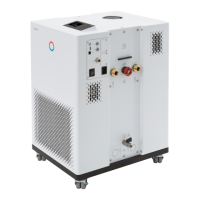3. Select one of the following options:
n [Oset source] allows you to select the source used to measure
the oset.
n [Di. set/actual value] allows you to enter the value for the set-
point oset.
1. Select the [Di. set/actual] button in the setpoint oset menu.
The entry window appears. An oset value can be entered within
the limits displayed.
2. Enter the setpoint oset.
3. Press the [Enter key] to confirm.
4. The software returns to the previous Setpoint oset menu.
You can activate or deactivate the value entered for the setpoint oset
of a corresponding source using the options in the [Oset source] menu.
[External Pt100], for example, allows you to activate the setpoint oset for
the external temperature probe.
1. Select the [Oset source] button in the Setpoint oset menu.
2. Select one of the following options:
n Select [O] to deactivate the oset source.
Activate an oset source from the remaining options:
n [Extern Pt100]
n [Extern analog]
n [Extern serial]
n [Extern USB]
n [Extern Ethernet]
n [Extern EtherCAT]
n [Extern Pt100-2]
3. Press the [Enter key] to confirm.
4. Press the [ESC] softkey to switch to the home window.
6.7 Limiting heating and cooling
The maximum heating power or max. cooling capacity can be limited using
the controller output limit. The limit is set as a percentage of the maximum
value.
The controller output limit for the heating output is designed to prevent
excessive temperatures on the surface of the heater. Excessive heater tem-
peratures may degrade the heat transfer liquid.
1. Press the [Enter key] to open the menu.
2.
Select the menu items Setup Control Cont.outp.limit.
3. Select [Max. heating] and press [OK] to confirm.
An entry window appears. The controller output limit can be set to
a value within the limits displayed.
4. Change the value accordingly.
Entering the oset value
Activating an oset source
V6 Integral Process Thermostats and High-Temperature Thermostats 95 / 198

